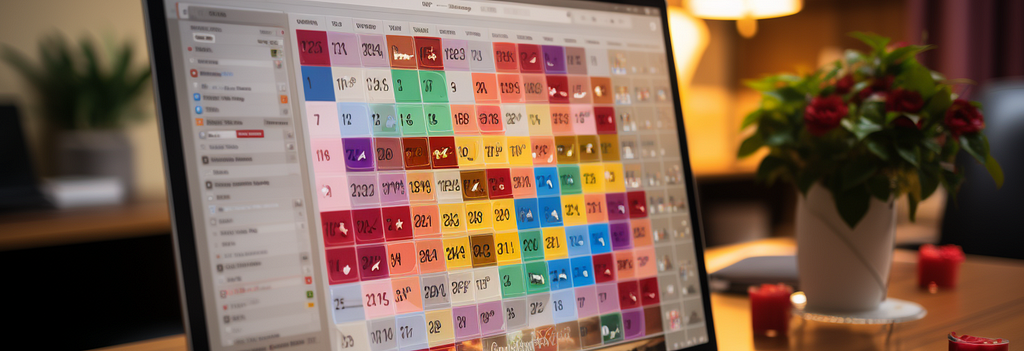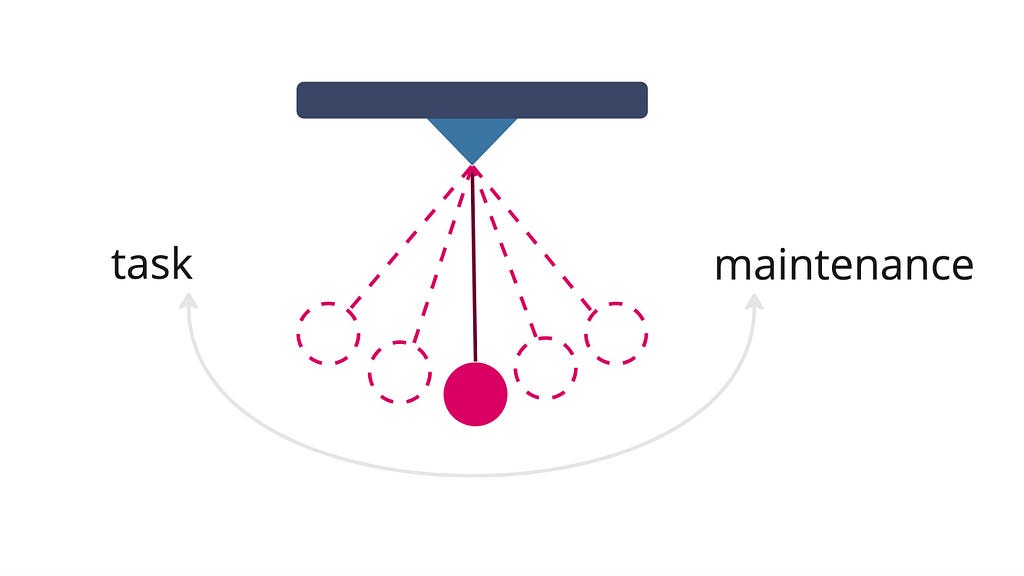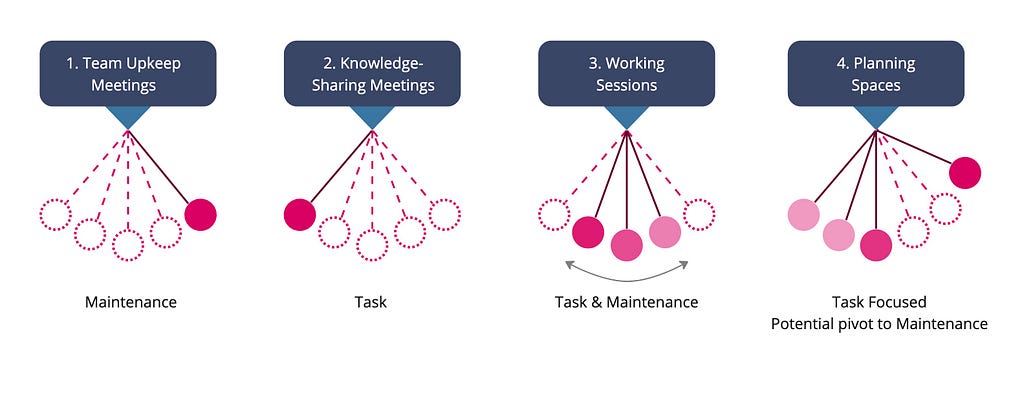When it comes to group dynamics, there are two key factors that play a crucial role: task-oriented and maintenance-oriented behaviors. As you plan your team’s agenda, consider how these factors influence the dynamics and productivity of the group.

“Not another meeting…” or “this could have been an email…” are clear indications that your team’s meetings or rituals may not be effective. Constant meeting invitations overwhelm our agendas. People wish they could focus on what they are trained for and skilled at, such as coding, designing, or writing. However, in a world of multidisciplinary teams striving for innovation, meetings are crucial. Some are more valuable than others.
As a team manager, I take a holistic approach to this issue. I look at the whole agenda, mine and my team’s, and try to imagine the value of each meeting. I pay attention to the presence of an equilibrium problem. An equilibrium problem, as described by Hare (1973), following laboratory and natural settings group experiments, is maintaining the balance of forces between task and maintenance-oriented spaces.
Group dynamics are influenced by two primary factors: task-oriented behaviors and maintenance-oriented behaviors.
- Task-oriented behaviors: These are the actions and efforts of group members focused on achieving the group’s objectives, completing tasks, and reaching specific goals.
- Maintenance-oriented behaviors: These involve interpersonal interactions and supportive actions among group members that contribute to the group’s cohesion, cooperation, and overall well-being.
According to Hare (1973), both factors are crucial for a group’s success. A successful group finds the right balance between these two aspects, effectively navigating challenges, staying motivated, and achieving shared objectives. When groups struggle to work together, it’s often due to an imbalance between task and maintenance, or an issue with their equilibrium. Groups work best when they learn to strike a balance and swing along the pendulum between task and maintenance.

All meetings ultimately serve both functions, task and maintenance. But their primary focus, whether task-oriented or maintenance-oriented, creates distinct team spaces with different outcomes.
The easiest way to spot an equilibrium problem is to look for signs in task-oriented meetings. Some signs that speak of the equilibrium problem show up as:
- a group spending excessive time negotiating work processes instead of focusing on the tasks;
- difficulties in decision-making in the group;
- not respecting decisions made in a previous meeting;
- group members seeming disengaged;
- fluctuating flight or fight responses (Marshak, 2016), such as group members seeking ways to exit the meeting, or spending disproportionate time debating minutiae;
- dissatisfaction or lack of ownership towards completed tasks.
Do they seem familiar?
These issues suggest that the group functions more as a collection of individuals instead of a cohesive team. It might be because they might lack “group maintenance” spaces, where the group reflects inwardly on group dynamics and individual needs.
“As a result of their continued attention to ‘social-emotional’ problems, the low status consensus groups tend to be less efficient and less satisfied with their group and with their group’s solution to the problem” (Hare, 1973). Although it may be possible for a group to continue task work while lacking sufficient space for maintenance, the quality of the group’s output and the group members’ experience are likely to deteriorate.
To better understand if our process is balanced, let’s begin by examining the types of meetings on our agenda. By doing this, we can easily identify if we have the right equilibrium. So, let’s take a look at the different types of meetings that frequently appear on our schedules:

1. Team upkeep meetings — maintenance
Team upkeep meetings are essential for a team to discuss, evaluate, reflect, and negotiate their collaboration. These meetings form the foundation of the team’s dynamics and culture. When facilitated well, this type of meeting ensures that all voices are heard.
Familiar meeting formats:
Sprints, Retrospectives, Post mortems, Landings, Team Building, 1on1s, Coaching sessions, Mentoring Sessions and so on.
In these meetings, I help the group address the unsaid aspects that often go unnoticed in other meetings. Yes, it is a meeting about feelings. We explore how we feel about working together, the team’s mandate, and the existing processes. The outcome is a list of actionable items on how to improve the way WE work. The process must enable us and support each of our individual needs, a.k.a. “humans over processes” (Manifesto for Agile Software Development, n.d.).
For instance, if a parent needs to pick up their child at 4:30 pm but the 15-minute stand-up meeting is scheduled for 4:00 pm, the parent might consistently appear distracted in the meeting. Asking the group how they feel the stand-up is going for them might encourage the parent to express that they alway feel rushed, which could lead to the solution of the group adjusting the meeting time. This helps reduce stress and anxiety, ensuring that nobody feels like they’re working less than others.
These types of meetings require skillful and caring facilitation. But also keeping and following up on action items. Unfortunately, I’ve witnessed retrospectives that involve meaningful discussions and vulnerable sharing that do not end up in actionable items. Vulnerability takes courage and an emotional toll on group members, and if it does result in change, it results in disengagement. This leads to the group questioning if these meetings are even needed. When I hear phrases like “Should we just cancel the retrospective?” it concerns me, as it indicates the group or individual is ready to give up on finding better ways to work together.
One-on-one meetings between peers, managers, and their reports can fall in the same category as “group-maintenance”. Even when two coworkers gather for project work, they may delve into more personal aspects, discussing about themselves, kids, the overall work environment and their thoughts and feelings. According to Gibbs theory of Trust Formation; intimacy, genuineness, and straightforward communication happens in pairs (Kass, 2015). As a manager, on my one-on-one meetings, I spend a bit of time on creating a bond of trust and intimacy. Simply, just asking the other person “How are you doing?”.
Maintenance meetings are critical for the team’s overall health and should account for about 10% of the team’s time spent in meetings.
It’s not about the quantity of time spent in the meeting but rather about the changes we implement outside of it that truly matter.
Prodromes of improvement needed of maintenance meetings:
- Questioning the need: “Do we need it?”, “Should we have maybe 1h every three months?”
- Lack of attendance: “Do you mind if I skip this one, I have work to do.”; “Maybe we will cancel this one.”
- Disconnection: “I don’t feel we are a team”; “We decided on a direction, and two days later, I am very surprise my colleagues’ output,” “I’m having trouble working with them”
- Ask for external help: “The process in this team is not very clear, we need someone to create a workflow for us”; “I am not sure why we are doing this, but I’m going along with the process”
2. Knowledge-sharing meetings — task
The purpose of knowledge-sharing meetings is for coworkers to share status, knowledge, or other helpful information related to a task with the group. In tech, familiar formats are daily stand-ups, demos, stakeholder updates and so on.
Familiar meeting formats:
Daily Stand-Ups, Stakeholder updates, Product Demos, Brown Bag Lunches, Expert Panel Discussions, Community of Practice Meetings, Client Demos, User Interviews
Knowledge-sharing meetings typically follow a pre-established agenda with minimal or no facilitation, often becoming team rituals. For example, a stand-up meeting involves a round table where each participant answers three questions, while a Sprint Demo format focuses on reviewing completed work and discussing upcoming tasks.
Knowledge-sharing is a sub-function of all meetings.
For instance, Design Critiques, on which I describe in this article, primarily harvest input and share knowledge in design practices. Similarly, pair-to-pair programming working sessions in engineering are secondary to teaching and sharing expert knowledge. Traditional stand-up meetings may not be necessary in a cohesive team environment with a lean workflow. Nobody likes an endless repetition of tasks. If information flows smoothly through other synchronous sessions and asynchronous channels or information is readily available, stand-up becomes an overkill, a.k.a. “could have been an email”.
Determining the ideal percentage of knowledge-sharing meetings can be challenging. However, I would pay attention if some knowledge-sharing sessions are mere reporting meetings, indicating a top-down management culture. Well, that is also knowledge-sharing with your leadership, but maybe there are better formats than a controlling and soul-crushing report meeting: “I sent you an email, but maybe you didn’t read it.”
Prodromes of lack of knowledge-sharing meetings:
- Duplication of work
- Siloed knowledge
- Lack of information flow which leads to delays in decision-making, or refactoring work
- Different standards of quality or output from similar teams
3. Working sessions — maintenance and task
Working sessions are the type of meetings where participants focus on the execution of a given task. As a standard, they have a clear goal. But there is no set agenda and a fluid time frame. Work sessions can be impromptu, ad-hoc hangouts or rituals. Work sessions with 3 or more people tend to mainly be “task” types.
Familiar meeting formats:
Ideation, Brainstorming, Pair Programming, 3 Amigos Testing, Design or Prototyping Sessions.
Conversely, a 2-person work sessions are “task” but with a strong side of “Maintenance.” Schutz, in his Three Dimensional Theory of Interpersonal and Group Behaviour, also observes that openness only happens in pairs of people and leads to stronger interpersonal bonds between group members. Those affectional bonds are “crucial to the survival of the group” (Kass, 2015). Pair work sessions, even if task-oriented, create a more intimate space in a non-intimate context where both participants are engaged intellectually and emotionally.
You and your team should spend most of the overall meeting time in work sessions. Ultimately we are there to find solutions and deliver them. But pay attention if these work sessions truly concentrate on problem-solving and task completion. However, if most work sessions involve multiple participants with varying levels of hierarchy and lack clarity in the task or struggle with decision-making, it could indicate underlying issues. Normally that means that the task is not well-defined or the group faces challenges in making effective decisions.
Prodromes of dysfunctional group dynamics if observing work sessions:
- Work sessions tend to be larger and larger, but less movement forward
- Work sessions do not yield any results or increases the quality of the output
4. Planning spaces — task
Planning spaces are dedicated to bringing together relevant stakeholders to engage in future planning and strategic decisions. That is an intense and emotional space. And a planning session can last up to three days. You can’t put that in an email.
These meetings require a structured agenda, clear objectives, and a defined decision-making process to ensure that all perspectives are considered before reaching a conclusion. Effective facilitation is crucial to help with negotiation as individuals are expected to commit and take ownership of the outcomes.
Familiar meeting formats:
Strategic Planning, Agile Grooming Session, Backlog Grooming, Annual or Quarterly Planning, SWOT Analysis, Resource Planning, Scenario Planning Workshops, Roadmap Sessions and so on.
It is common for participants to have different understandings or perspectives on various subjects, such as time, capacity, problems to be solved, and measurable outputs. Those differences will always exist, but the depth might vary. Due to the intensity of the task and the contrast in understanding, different group dynamics might surface and hinder the task at hand.
Unbiased and experienced facilitation plays a crucial role in planning spaces. A facilitator can observe and intervene when differences in understanding arise. The facilitator can guide the group in acknowledging and addressing these differences, ensuring that each participant’s perspective is considered. This collaborative approach helps the group formulate a plan that reflects the input and ownership of all participants.
Laughter is key here. During those long full-day meetings, a good facilitator knows how to release tension through laughter and fun exercises and will provide well-timed breaks for recharging.
“Joking and laughter, indicating solidarity and tension release, become more frequent.” (Hare, 1973)
Prodromes of dysfunctional group dynamics in a planning session:
- Decision-making: There is no clear outcome, a second and third planning might be needed — “What is our mission again?”, “What are we trying to acchieve here?”
- Ownership: A lack of ownership after planning meetings, no follow-up agenda or actionable items — “This item is from last year, lets see if it happens this year…”, “I think we should park this for X to be in the room.”
- Lack of group cohesiveness: A strong fluctuation between flight or fight interaction between individuals — “This is my strong opinion, but I will go along with the group” or people passively participating without stating an opinion overall.
Let’s make our meetings more meaningful, efficient, and enjoyable by calibrating the meeting mix. Pause. Take a look at your meeting ecosystem through this classification.
First, which meetings are group-tasks and which group-maintenance as primary functions? What are the secondary roles for each meeting? Ask yourself “What is a good mix?” and “How can I create the right balance and the right milestones to calibrate that balance?” How does your team quarter look if you identify meetings based on?
Let’s make every meeting count! Or send it in an email.
Editor: Emma Parenteau
Bibliography
Hare, A. P. (1973). Theories of group development and categories for interaction analysis. Small Group Behavior, 4(3), 259–303.
Kass, R. (2015). Schutz’s Three Dimensional Theory of Interpersonal & Group Development. In Theories of Small Group Development (Fifth Edition). The Center for Human Relations and Community Studies.
Manifesto for Agile Software Development. (n.d.). Retrieved July 18, 2023, from http://agilemanifesto.org/
Further Readings
- The Types of Design Meetings
- Ceremonies of a design team
- Four agile ceremonies, demystified | Atlassian
- 3 Types of Meetings – and How to Do Each One Well
I sent an email, but nobody read it. So I sent out an invite. was originally published in UX Collective on Medium, where people are continuing the conversation by highlighting and responding to this story.